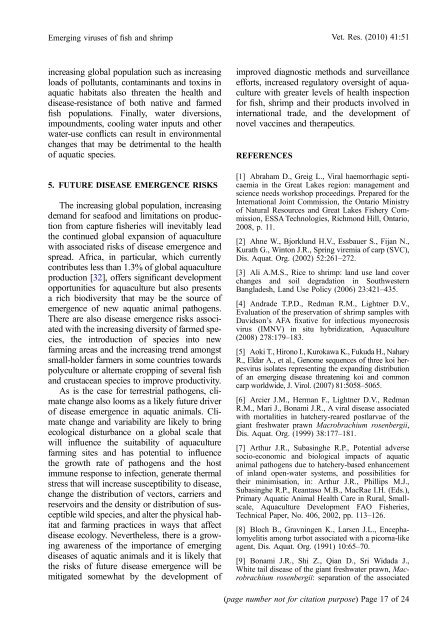Emerging viral diseases of fish and shrimp - Watershed Watch ...
Emerging viral diseases of fish and shrimp - Watershed Watch ...
Emerging viral diseases of fish and shrimp - Watershed Watch ...
You also want an ePaper? Increase the reach of your titles
YUMPU automatically turns print PDFs into web optimized ePapers that Google loves.
<strong>Emerging</strong> viruses <strong>of</strong> <strong>fish</strong> <strong>and</strong> <strong>shrimp</strong> Vet. Res. (2010) 41:51<br />
increasing global population such as increasing<br />
loads <strong>of</strong> pollutants, contaminants <strong>and</strong> toxins in<br />
aquatic habitats also threaten the health <strong>and</strong><br />
disease-resistance <strong>of</strong> both native <strong>and</strong> farmed<br />
<strong>fish</strong> populations. Finally, water diversions,<br />
impoundments, cooling water inputs <strong>and</strong> other<br />
water-use conflicts can result in environmental<br />
changes that may be detrimental to the health<br />
<strong>of</strong> aquatic species.<br />
5. FUTURE DISEASE EMERGENCE RISKS<br />
The increasing global population, increasing<br />
dem<strong>and</strong> for seafood <strong>and</strong> limitations on production<br />
from capture <strong>fish</strong>eries will inevitably lead<br />
the continued global expansion <strong>of</strong> aquaculture<br />
with associated risks <strong>of</strong> disease emergence <strong>and</strong><br />
spread. Africa, in particular, which currently<br />
contributes less than 1.3% <strong>of</strong> global aquaculture<br />
production [32], <strong>of</strong>fers significant development<br />
opportunities for aquaculture but also presents<br />
a rich biodiversity that may be the source <strong>of</strong><br />
emergence <strong>of</strong> new aquatic animal pathogens.<br />
There are also disease emergence risks associated<br />
with the increasing diversity <strong>of</strong> farmed species,<br />
the introduction <strong>of</strong> species into new<br />
farming areas <strong>and</strong> the increasing trend amongst<br />
small-holder farmers in some countries towards<br />
polyculture or alternate cropping <strong>of</strong> several <strong>fish</strong><br />
<strong>and</strong> crustacean species to improve productivity.<br />
As is the case for terrestrial pathogens, climate<br />
change also looms as a likely future driver<br />
<strong>of</strong> disease emergence in aquatic animals. Climate<br />
change <strong>and</strong> variability are likely to bring<br />
ecological disturbance on a global scale that<br />
will influence the suitability <strong>of</strong> aquaculture<br />
farming sites <strong>and</strong> has potential to influence<br />
the growth rate <strong>of</strong> pathogens <strong>and</strong> the host<br />
immune response to infection, generate thermal<br />
stress that will increase susceptibility to disease,<br />
change the distribution <strong>of</strong> vectors, carriers <strong>and</strong><br />
reservoirs <strong>and</strong> the density or distribution <strong>of</strong> susceptible<br />
wild species, <strong>and</strong> alter the physical habitat<br />
<strong>and</strong> farming practices in ways that affect<br />
disease ecology. Nevertheless, there is a growing<br />
awareness <strong>of</strong> the importance <strong>of</strong> emerging<br />
<strong>diseases</strong> <strong>of</strong> aquatic animals <strong>and</strong> it is likely that<br />
the risks <strong>of</strong> future disease emergence will be<br />
mitigated somewhat by the development <strong>of</strong><br />
improved diagnostic methods <strong>and</strong> surveillance<br />
efforts, increased regulatory oversight <strong>of</strong> aquaculture<br />
with greater levels <strong>of</strong> health inspection<br />
for <strong>fish</strong>, <strong>shrimp</strong> <strong>and</strong> their products involved in<br />
international trade, <strong>and</strong> the development <strong>of</strong><br />
novel vaccines <strong>and</strong> therapeutics.<br />
REFERENCES<br />
[1] Abraham D., Greig L., Viral haemorrhagic septicaemia<br />
in the Great Lakes region: management <strong>and</strong><br />
science needs workshop proceedings. Prepared for the<br />
International Joint Commission, the Ontario Ministry<br />
<strong>of</strong> Natural Resources <strong>and</strong> Great Lakes Fishery Commission,<br />
ESSA Technologies, Richmond Hill, Ontario,<br />
2008, p. 11.<br />
[2] Ahne W., Bjorklund H.V., Essbauer S., Fijan N.,<br />
Kurath G., Winton J.R., Spring viremia <strong>of</strong> carp (SVC),<br />
Dis. Aquat. Org. (2002) 52:261–272.<br />
[3] Ali A.M.S., Rice to <strong>shrimp</strong>: l<strong>and</strong> use l<strong>and</strong> cover<br />
changes <strong>and</strong> soil degradation in Southwestern<br />
Bangladesh, L<strong>and</strong> Use Policy (2006) 23:421–435.<br />
[4] Andrade T.P.D., Redman R.M., Lightner D.V.,<br />
Evaluation <strong>of</strong> the preservation <strong>of</strong> <strong>shrimp</strong> samples with<br />
Davidson’s AFA fixative for infectious myonecrosis<br />
virus (IMNV) in situ hybridization, Aquaculture<br />
(2008) 278:179–183.<br />
[5] Aoki T., Hirono I., Kurokawa K., Fukuda H., Nahary<br />
R., Eldar A., et al., Genome sequences <strong>of</strong> three koi herpesvirus<br />
isolates representing the exp<strong>and</strong>ing distribution<br />
<strong>of</strong> an emerging disease threatening koi <strong>and</strong> common<br />
carp worldwide, J. Virol. (2007) 81:5058–5065.<br />
[6] Arcier J.M., Herman F., Lightner D.V., Redman<br />
R.M., Mari J., Bonami J.R., A <strong>viral</strong> disease associated<br />
with mortalities in hatchery-reared postlarvae <strong>of</strong> the<br />
giant freshwater prawn Macrobrachium rosenbergii,<br />
Dis. Aquat. Org. (1999) 38:177–181.<br />
[7] Arthur J.R., Subasinghe R.P., Potential adverse<br />
socio-economic <strong>and</strong> biological impacts <strong>of</strong> aquatic<br />
animal pathogens due to hatchery-based enhancement<br />
<strong>of</strong> inl<strong>and</strong> open-water systems, <strong>and</strong> possibilities for<br />
their minimisation, in: Arthur J.R., Phillips M.J.,<br />
Subasinghe R.P., Reantaso M.B., MacRae I.H. (Eds.),<br />
Primary Aquatic Animal Health Care in Rural, Smallscale,<br />
Aquaculture Development FAO Fisheries,<br />
Technical Paper, No. 406, 2002, pp. 113–126.<br />
[8] Bloch B., Gravningen K., Larsen J.L., Encephalomyelitis<br />
among turbot associated with a picorna-like<br />
agent, Dis. Aquat. Org. (1991) 10:65–70.<br />
[9] Bonami J.R., Shi Z., Qian D., Sri Widada J.,<br />
White tail disease <strong>of</strong> the giant freshwater prawn, Macrobrachium<br />
rosenbergii: separation <strong>of</strong> the associated<br />
(page number not for citation purpose) Page 17 <strong>of</strong> 24
















